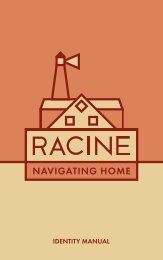Artful Magazine
Artful is about the subtle art, creativity and expression in daily life—the art in you, your environment, to your community. Student Work | Magazine Layout
Artful is about the subtle art, creativity and expression in daily life—the art in you, your environment, to your community.
Student Work | Magazine Layout
Create successful ePaper yourself
Turn your PDF publications into a flip-book with our unique Google optimized e-Paper software.
ART AS
Expression
An analysis of art, expression and existence.
By John Hospers
The view that “art is imitation (representation)” has not
only been challenged, it has been moribund in at least
some of the arts since the 19th century. It was subsequently
replaced by the theory that art is expression. Instead
of reflecting states of the external world, art is held to
reflect the inner state of the artist. This, at least, seems to
be implicit in the core meaning of expression: the outer
manifestation of an inner state. Art as a representation
of outer existence (admittedly “seen through a temperament”)
has been replaced by art as an expression of
humans’ inner life.
But the terms express and expression are ambiguous and
do not always denote the same thing. Like so many other
terms, express is subject to the process-product ambiguity:
the same word is used for a process and for the product
that results from that process. “The music expresses
feeling” may mean that the composer expressed human
feeling in writing the music or that the music when heard
is expressive (in some way yet to be defined) of human
feeling. Based on the first sense are theories about the
creation of art. Founded on the second are theories about
the content of art and the completion of its creation.
The creation of a work of art is the bringing about of
a new combination of elements in the medium (tones
in music, words in literature, paints on canvas, and so
on). The elements existed beforehand but not in the same
combination; creation is the re-formation of these pre-existing
materials.
That creation occurs in various art mediums is an obvious
truth. But once this is granted, nothing has yet been
said about expression, and the expressionist would say
that the foregoing statement about creation is too mild to
cover what needs to be said about the process of artistic
creation. The creative process, the expressionist wants to
say, is (or is also) an expressive process, and for expression
something more is necessary than that the artist be
creating something. Great care must be taken at this stage:
some say that the creation of art is (or involves) self-expression;
others say that it is the expression of feeling,
though not necessarily of one’s own feeling (or perhaps
that and something more, such as the feeling of one’s
race, or of one’s nation, or of all humanity); others say that
it is not necessarily limited to feelings but that ideas or
thoughts can be expressed, as they clearly are in essays.
But the distinctively expressionist view of artistic creation
Left: Nicole Shields
looks into the
camera.
Above: Neon
lights glow at the
Wisconsin Union in
Madison, Wis.
6
The Artful Ordinary






